In Solid Edge, you can draw 2D elements to help you complete a variety of tasks. For example, you can use 2D elements to construct features in the Part environment and to draw layouts in the Assembly environment.
In the Draft environment, you can use 2D drawing tools to complete a variety of tasks such as drawing sketches from scratch on the 2D Model sheet or in 2D views, creating background sheet graphics, and defining cutting planes for section views. The drawing commands, relationships, and dimensions work similarly in all environments.
You can draw any type of 2D geometric element in Solid Edge, such as lines, arcs, circles, B-spline curves, rectangles, and polygons.
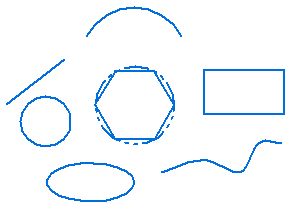
You can also use Solid Edge to do the following:
Move, rotate, scale, and mirror elements
Trim and extend elements
Add chamfers and fillets
Create precision graphics from a freehand sketch
Change the color of elements
Tools that work with the drawing commands -IntelliSketch, Intent Zones, and Grid - allow you to easily relate elements to each other, define your drawing intentions as you sketch, and provide precise coordinate input relative to any key position in the drawing.
Use Solid Edge drawing commands to provide input by clicking in the graphics window, or by typing values in command bar boxes. No strict input order is required.
It is often productive to use a combination of graphics window and command bar input. For example, you can type a line length in the command bar, press the Enter or Tab key to lock the value, then set the orientation angle of the line in the graphics window. Or you can use the drawing command dynamics to get a graphic idea of the size and orientation you want, then type values in the command bar boxes to provide more precise input.
You can use the Line Color option on the element command bar to apply colors to 2D elements. You can click the More option on the Colors dialog box to define custom colors.
As you draw, the software shows a temporary, dynamic display of the element you are drawing (A). This temporary display shows what the elements will look like if you click at the current cursor position.
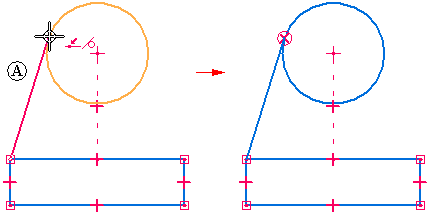
Until you click the point that completely defines the element that you are drawing, values in the command bar boxes update as you move the cursor. This gives you constant feedback on the size, shape, position, and other characteristics of the elements you draw.
When you lock a value by typing it into a command bar box, the dynamic display of the element you are drawing shows that the value is locked. For example, if you lock the length of a line, the length of the dynamic line does not change as you move the cursor to set the angle. If you want to free the dynamics for a value, you can clear the value box by double-clicking in the box and pressing the Backspace or Delete key.
As you draw, IntelliSketch recognizes and applies 2D relationships that control element size, shape, and position. When you make changes, relationships help the drawing retain the characteristics you do not want altered.
When a relationship indicator is displayed at the cursor, you can click to apply that relationship. For example, if the horizontal relationship indicator is displayed when you click to place the end point of a line, the line will be drawn exactly horizontal. You can also apply relationships to elements after you draw them.

Relationship handles displayed on the 2D geometry show you how elements are related. You can remove any relationship by deleting its handle. You can display or hide the relationship handles with the Relationship Handles command.
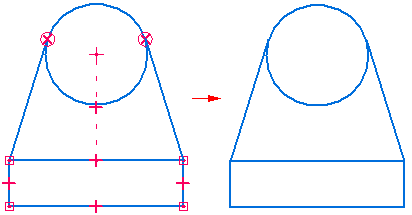
You can draw and modify 2D elements in the way that best suits your design needs. You can make your assembly layouts and drawings associative by applying relationships, or you can draw them freely, without relationships. When you draw 2D elements in a part document, 2D relationships are maintained.
Maintaining relationships between 2D elements makes the elements associative (or related) to each other. When you modify a 2D element that is related to another 2D element, the other element updates automatically. For example, if you move a circle that has a tangent relationship with a line, the line also moves so that the elements remain tangent.
You can draw elements freely, or non-associatively. When you modify a non-associative portion of an assembly sketch or drawing, the changed elements move freely, without changing other portions of the design. For example, if you move a circle that is tangent to a line (but does not have a tangent relationship with the line) the line does not move with the circle.
To control whether you draw and modify 2D elements freely or associatively in layouts and drawings, use the Maintain Relationships command in the Assembly and Draft environments.
Note:
When you construct a synchronous feature using the 2D elements, the sketch elements are moved to the Used Sketches collector in PathFinder.
An element that has no relationships applied can be moved and changed in various ways. For example, when there are no relationships between two lines (A), the lines can be moved and changed without affecting each other. If you apply a perpendicular relationship between the two lines (B), and move one line, the lines remain perpendicular.
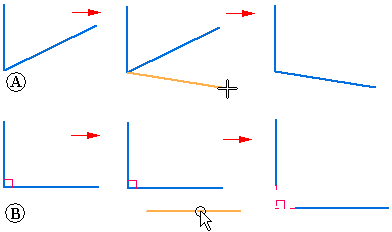
When you apply a relationship between elements, the relationship is maintained when you modify either element. For example:
If a line and an arc share a tangent relationship, they remain tangent when either is modified.
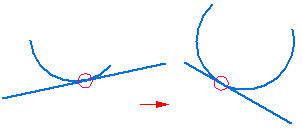
If a line and arc share a connect relationship, they remain connected when either is modified.

Relationships also maintain physical characteristics such as size, orientation, and position.
You can make the size of two circles equal with an equal relationship.
You can make the orientation of two lines parallel with a parallel relationship.
You can connect a line and an arc with a connect relationship.
A relationship can also maintain a physical characteristic of an individual element. For example, you can make a line horizontal. The line remains horizontal even if you change its position and length.

For 2D elements you draw in a part or assembly document, you can specify that the element is a considered a construction element. The Construction command on the Sketching tab allows you to specify that an element is a construction element. Construction elements are not used to construct features--they are used only as drawing aids. The line style for a construction element is dashed.